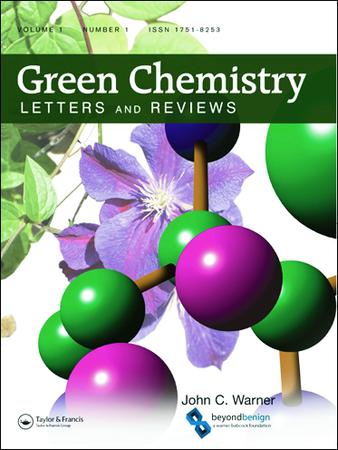Degradation of the dye methyl orange using cow and goat milk iron nanoparticles
IF 5.8
3区 化学
Q1 CHEMISTRY, MULTIDISCIPLINARY
引用次数: 1
Abstract
ABSTRACT Environmental pollution is a global issue, and the contamination of water by dyes is a matter of concern. This work reports an environmentally friendly method for degrading methyl orange dye using iron nanoparticles (INPs) synthesized from pasteurized cow and goat milk and ferric chloride (FeCl3). INPs were synthesized using FeCl3 and milk mixed in a 1:2 (v/v) ratio and subsequently heated at 70 0C. The formation of INPs was monitored by visualizing the color changes. The synthesized NPs were characterized by FTIR, SEM, EDS, TEM, XRD, and XPS. The XRD results showed that INPs were formed and had an amorphous structure. TEM data showed smaller semi-spherical particles with sizes of 8-27 nm, and they were present in an aggregated state. Dye degradation studies were conducted using INP with UV light exposure and H2O2 addition. Both the processes were monitored using UV/Vis scans at different time intervals. The results showed that the degradation of methyl orange was faster in the presence of H2O2 (over 85% efficiency in 60 min) than in the presence of UV light. The current study shows that the INPs formed using milk have the potential to be used as catalysts in azo dye degradation reactions. GRAPHICAL ABSTRACT利用牛和山羊奶铁纳米颗粒降解甲基橙染料
本文章由计算机程序翻译,如有差异,请以英文原文为准。
求助全文
约1分钟内获得全文
求助全文
来源期刊

Green Chemistry Letters and Reviews
CHEMISTRY, MULTIDISCIPLINARY-GREEN & SUSTAINABLE SCIENCE & TECHNOLOGY
CiteScore
9.10
自引率
3.00%
发文量
48
期刊介绍:
Green Chemistry Letters and Reviews is an Open Access, peer-reviewed journal focused on rapid publication of innovative new syntheses and procedures that reduce or eliminate the use and generation of hazardous materials. Reviews of state-of-the-art green chemistry technologies are also included within the journal''s scope.
Green Chemistry Letters and Reviews is divided into three overlapping topic areas: research, education, and industrial implementation. The journal publishes both letters, which concisely communicate the most time-sensitive results, and reviews, which aid researchers in understanding the state of science on important green chemistry topics. Submissions are encouraged which apply the 12 principles of green chemistry to:
-Green Chemistry Education-
Synthetic Reaction Pathways-
Research and Process Analytical Techniques-
Separation and Purification Technologies-
Renewable Feedstocks-
Degradable Products
 求助内容:
求助内容: 应助结果提醒方式:
应助结果提醒方式:


